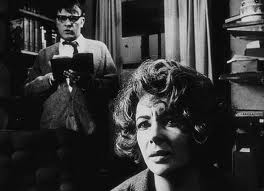Yes, I have three pieces in today’s Wall Street Journal! Starting this morning, my biweekly “Sightings” column about the arts in America will appear in the Leisure & Arts section of the Friday Journal (instead of the Saturday paper, which has just been extensively redesigned). In my first Friday column, I talk about…well, see for yourself. Here’s an excerpt.
* * *
Sometimes a passing comment can be more telling than a considered one. In reviewing the recent New York premiere of “Me, Myself & I,” Edward Albee’s latest play, I remarked that “Who’s Afraid of Virginia Woolf?” is “the only one of Mr. Albee’s 30 plays to have made an enduring impression on the general public–indeed, it’s possible that ‘Virginia Woolf’ could be the last American play of any kind to have made such an impression.” A number of readers wrote to me about that observation, and their reactions can be boiled down into a one-word reply: Really? So I gave it some additional thought, and the more I thought about it, the more certain I became that I’d inadvertently put my finger on something that is of relevance not just to Mr. Albee’s career, but to the increasingly shaky standing of high culture in postmodern America….
 Forty-eight years after the fact, it’s easy to forget that the controversy that greeted the premiere of “Virginia Woolf,” which in 1962 was thought by many Americans to be frank to the point of obscenity, made Edward Albee famous. How famous? Enough so that Johnny Carson invited him onto “The Tonight Show” four years later to promote his latest play, “A Delicate Balance.” (He shared the Carson couch with Duke Ellington.) Not long afterward, Life magazine published a lengthy, lavishly illustrated profile of Mr. Albee. In the ’60s, you couldn’t get much more famous than that….
Forty-eight years after the fact, it’s easy to forget that the controversy that greeted the premiere of “Virginia Woolf,” which in 1962 was thought by many Americans to be frank to the point of obscenity, made Edward Albee famous. How famous? Enough so that Johnny Carson invited him onto “The Tonight Show” four years later to promote his latest play, “A Delicate Balance.” (He shared the Carson couch with Duke Ellington.) Not long afterward, Life magazine published a lengthy, lavishly illustrated profile of Mr. Albee. In the ’60s, you couldn’t get much more famous than that….
Back then, the national media still devoted a considerable amount of time and space to covering high culture. Even if you didn’t live in New York, you could still read a review of an important play in a weekly newsmagazine, watch a scene being performed by the original cast on “The Ed Sullivan Show” or see the author being interviewed on “Tonight” or “Today.” Moreover, wire-service coverage of big-city cultural events was routinely carried by local newspapers throughout the country. As a result, it was possible well into the ’70s for a high-culture artist to become known to the public at large….
No more. The national media have mostly stopped covering high culture–nowadays they are besotted by Hollywood–meaning that it is no longer possible for an artist like Mr. Albee to win true fame….
* * *
Read the whole thing here.
Terry Teachout on the arts in New York City
An ArtsJournal Blog
